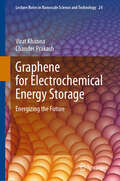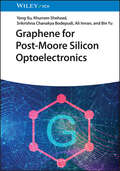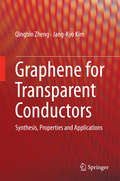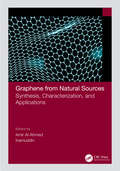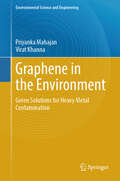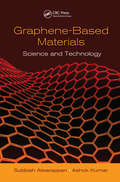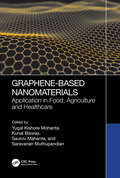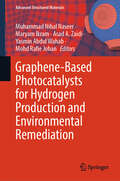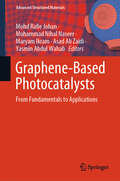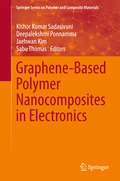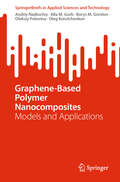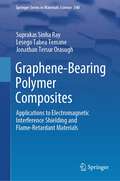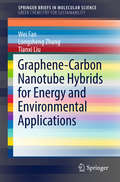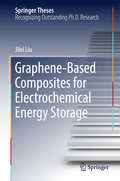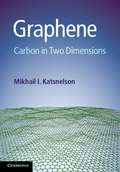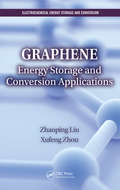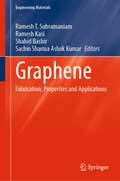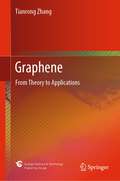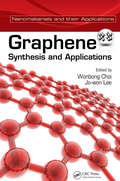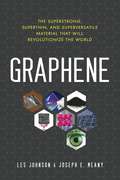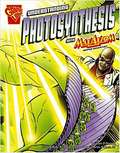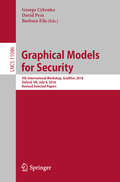- Table View
- List View
Graphene for Electrochemical Energy Storage: Energizing the Future (Lecture Notes in Nanoscale Science and Technology #24)
by Chander Prakash Virat KhannaThis book is a comprehensive overview of the latest developments in the field of graphene-based electrochemical energy storage devices. Graphene is considered one of the most promising materials for developing high-performance electrochemical energy storage devices due to its large surface area, high electrical conductivity, and superior mechanical strength. This book highlights its fundamental properties, synthesis methods, and various electrochemical energy storage applications such as in supercapacitors, batteries, and fuel cells. The first chapter introduces the electronic, mechanical, and thermal properties of graphene and discusses various synthesis methods such as mechanical exfoliation, chemical vapor deposition, and epitaxial growth. Additionally, it describes the functionalization of graphene to enhance its characteristics for electrochemical energy storage applications. The second chapter focuses on the application of graphene in supercapacitors, energy storage devices that require high power density. It details different types of supercapacitors such as electrochemical capacitors, pseudo capacitors, and hybrid capacitors and discusses how graphene can enhance their performance. The third chapter covers the use of graphene in batteries, describing how graphene-based anodes and cathodes improve energy density, cycling stability, rate capability across various battery types including lithium-ion, sodium-ion, and zinc-ion batteries. The final chapter is dedicated to the use of graphene in fuel cells, electrochemical devices that transform chemical energy into electrical power, and describes how graphene-based materials can be utilized as catalysts or supports within fuel cells for improved performance and durability. Various types of fuel cells such as proton exchange membrane fuel cells, direct methanol fuel cells, and solid oxide fuel cells are examined. The book concludes by highlighting the future prospects and challenges in graphene-based electrochemical energy storage applications. Written in a succinct and clear manner, this book serves as a modern reference on the topic and is a valuable resource for researchers, scientists, and engineers working in the area of energy storage.
Graphene for Post-Moore Silicon Optoelectronics
by Yang Xu Bin Yu Ali Imran Khurram Shehzad Srikrishna Chanakya BodepudiGraphene for Post-Moore Silicon Optoelectronics Provides timely coverage of an important research area that is highly relevant to advanced detection and control technology Projecting device performance beyond the scaling limits of Moore’s law requires technologies based on novel materials and device architecture. Due to its excellent electronic, thermal, and optical properties, graphene has emerged as a scalable, low-cost material with enormous integration possibilities for numerous optoelectronic applications. Graphene for Post-Moore Silicon Optoelectronics presents an up-to-date overview of the fundamentals, applications, challenges, and opportunities of integrating graphene and other 2D materials with silicon (Si) technologies. With an emphasis on graphene-silicon (Gr/Si) integrated devices in optoelectronics, this valuable resource also addresses emerging applications such as optoelectronic synaptic devices, optical modulators, and infrared image sensors. The book opens with an introduction to graphene for silicon optoelectronics, followed by chapters describing the growth, transfer, and physics of graphene/silicon junctions. Subsequent chapters each focus on a particular Gr/Si application, including high-performance photodetectors, solar energy harvesting devices, and hybrid waveguide devices. The book concludes by offering perspectives on the future challenges and prospects of Gr/Si optoelectronics, including the emergence of wafer-scale systems and neuromorphic optoelectronics. Illustrates the benefits of graphene-based electronics and hybrid device architectures that incorporate existing Si technology Covers all essential aspects of Gr/Si devices, including material synthesis, device fabrication, system integration, and related physics Summarizes current progress and future challenges of wafer-scale 2D-Si integrated optoelectronic devices Explores a wide range of Gr/Si devices, such as synaptic phototransistors, hybrid waveguide modulators, and graphene thermopile image sensors Graphene for Post-Moore Silicon Optoelectronics is essential reading for materials scientists, electronics engineers, and chemists in both academia and industry working with the next generation of Gr/Si devices.
Graphene for Transparent Conductors
by Qingbin Zheng Jang-Kyo KimThis book provides a systematic presentation of the principles and practices behind the synthesis and functionalization of graphene and grapheme oxide (GO), as well as the fabrication techniques for transparent conductors from these materials. Transparent conductors are used in a wide variety of photoelectronic and photovoltaic devices, such as liquid crystal displays (LCDs), solar cells, optical communication devices, and solid-state lighting. Thin films made from indium tin oxide (ITO) have thus far been the dominant source of transparent conductors, and now account for 50% of indium consumption. However, the price of Indium has increased 1000% in the last 10 years. Graphene, a two-dimensional monolayer of sp2-bonded carbon atoms, has attracted significant interest because of its unique transport properties. Because of their high optical transmittance and electrical conductivity, thin film electrodes made from graphene nanosheets have been considered an ideal candidate to replace expensive ITO films. Graphene for Transparent Conductors offers a systematic presentation of the principles, theories and technical practices behind the structure-property relationship of the thin films, which are the key to the successful development of high-performance transparent conductors. At the same time, the unique perspectives provided in the applications of graphene and GO as transparent conductors will serve as a general guide to the design and fabrication of thin film materials for specific applications.
Graphene from Natural Sources: Synthesis, Characterization, and Applications
by Amir Al-AhmedThis book examines the synthesis of graphene obtained from different natural raw materials and waste products as a low-cost, environmentally friendly alternative that delivers a quality final product. Expert researchers review potential sources of natural raw materials and waste products, methods or characterization, graphene synthesis considerations, and important applications. FEATURES Explores the different approaches to the synthesis of graphene oxide (GO) and reduced graphene oxide (rGO) from natural and industrial carbonaceous wastes Outlines the modification and characterization methods of GO and rGO Addresses the characterization methods of GO and rGO Details applications of GO and rGO created from natural sources Graphene is a multidisciplinary material with applications in almost every sector of science and engineering. Graphene from Natural Sources: Synthesis, Characterization, and Applications is a noteworthy reference for material scientists and engineers in academia and industry interested in reducing costs and employing green synthesis methods in their work.
Graphene in the Environment: Green Solutions for Heavy Metal Contamination (Environmental Science and Engineering)
by Virat Khanna Priyanka MahajanThis book explores the use of graphene in heavy metal cleanup. The introductory chapter contains enough information for understanding graphene, including its synthesis, characterisation, and amazing mechanical, electrical, and thermal properties. The risks of compounds like lead, mercury, cadmium, and arsenic are also explained, along with the dangerous effects of heavy metals. The next chapters go into great detail about the ways by which graphene expertly adsorbs heavy metal ions. The ability of graphene to absorb heavy metals and the extraordinary adsorption characteristics that explain graphene&’s efficiency in heavy metal removal are well explained. This book also shows how graphene may be dynamically combined with other materials to create potent nanocomposites with improved heavy metal cleanup capabilities. The environmental and safety implications of these ground-breaking solutions are also well given in detail. In addition to discussing the potential environmental issues associated with the discharge of graphene particles, the complexity of graphene dispersion, scalability, and cost-effectiveness are also covered. This book ends by looking towards the future prospects of how graphene will change its role in heavy metal cleaning and continue to advance in the same domain. This book is an attempt to explore a cutting-edge area of materials science and environmental protection. It connects the extraordinary qualities of graphene, and heavy metal contamination in pursuit of a cleaner environment and is a good resource for scholars, academicians, and environmental practitioners by revealing a thorough examination of the crucial part that graphene plays in tackling heavy metal contamination.
Graphene-Based Materials as Adsorbents for Wastewater Decontamination
by Suprakas Sinha Ray Lesego Tabea Temane Jonathan Tersur Orasugh Sarah Constance MotshekgaThis book aims to provide a fundamental grasp of graphene-based materials (GAMs) and their adsorption process. The effect of diverse process parameters, including pH, temperature, agitation, competing ions, etc., on the adsorption performance of GAMs as well as their recent and relevant applications in biomedical fields, are discussed. The current challenges and future outlook have been addressed as an independent chapter, and the recyclability of these adsorbent materials has also been covered.Features: Focuses on graphene-based materials as adsorbents to remove contaminants from wastewater. Includes detailed computational and statistical analyses and cost comparison points. Compares the performance of graphene-based materials as adsorbents in the context of various other reported adsorbents, including other 2D materials, such as WS2 and BN. Provides fundamental comprehension of the graphene-based materials’ adsorption process. Discusses the recyclable nature of graphene-based materials, as well as approaches used. This book has been aimed at graduate students and researchers in wastewater treatment, environmental, materials, and chemical engineering.
Graphene-Based Materials: Science and Technology
by Ashok Kumar Subbiah AlwarappanContinuously studied since its discovery, graphene offers truly unique opportunities, because unlike most semiconductor systems, its 2D electronic states are not buried deep under the surface and it can be easily accessed directly by tunneling or by other local probes. An in-depth analysis of recent advances in graphene research, Graphene-Based Mat
Graphene-Based Nanomaterials: Application in Food, Agriculture and Healthcare
by Yugal Kishore Mohanta Saurov Mahanta Kunal Biswas Saravanan MuthupandianThe book presents a comprehensive overview of the historical, current, and prospective application realms of nanobiotechnological research pertaining to graphene, a carbon-based nanomaterial, and its diverse forms in the fields of food and agriculture, as well as health sciences and technology. Young nanotechnologists and businesses will have access to nanobioanalytical methods. Given the present circumstances, it is crucial to underscore the potential ramifications that diverse forms of graphene nanomaterials could have on the food sector, agricultural methodologies, and healthcare. This book presents an analysis of the potential advantages of graphene-based nanomaterials over traditional materials in the food, agriculture, and health care sectors. This book employs case studies, academic and theoretical literature, technology transfer, innovation, economics, and policy management to underscore the intricate issues associated with graphene nanomaterials. The pioneering text Graphene-Based Nanomaterials: Application in Food, Agriculture, and Healthcare has the potential to serve as a valuable resource for interdisciplinary researchers, academics, practitioners, policymakers, and professionals operating within the fields of science, technology, engineering, innovation, management, and economics. Features · Discusses the different aspects of graphene as a two-dimensional material and its underlying unique physicochemical properties, synthesis methods, and protocols. · Considers the implications of graphene in the food sciences and its different spoilage detection mechanisms have been encompassed in the book. · Explores graphene nanomaterials' medical and biomedical uses. With examples, the unique and tailor-made material's uses and prospects in health sciences, pharmaceutics, and biomedical research are highlighted. · Elaborates on graphene's applications in agriculture and briefs the potential of biocompatible planar conductive nanoscale materials to boost agri-product production, crop development, and crop-infection surveillance.
Graphene-Based Photocatalysts for Hydrogen Production and Environmental Remediation (Advanced Structured Materials #219)
by Yasmin Abdul Wahab Asad A. Zaidi Muhammad Nihal Naseer Maryam Ikram Mohd Rafie JohanThis book delves into the cutting-edge applications of graphene-based photocatalysts, unveiling their immense potential in addressing two critical global challenges: sustainable hydrogen production and environmental remediation. Through insightful analysis of the state of the art, the book highlights the remarkable capabilities of these innovative materials in harnessing the power of light to drive chemical reactions. By exploring the synthesis, characterization, and mechanisms of graphene-based photocatalysts, the book provides knowledge not only about the fundamental concepts but also recent advancements in water splitting for hydrogen generation, as well as the degradation of persistent organic pollutants and greenhouse gases. With its extensive coverage and interdisciplinary approach, this resource is tailored for a diverse readership, including materials scientists, chemists, photocatalysis experts, environmental engineers, and professionals working in the fields of renewable energy, water treatment, and environmental remediation.
Graphene-Based Photocatalysts: From Fundamentals to Applications (Advanced Structured Materials #217)
by Yasmin Abdul Wahab Muhammad Nihal Naseer Maryam Ikram Mohd Rafie Johan Asad Ali ZaidiThis book provides a comprehensive overview of graphene-based photocatalysts, from the fundamentals to the applications. Graphene, the special material of the twenty-first century, has unique properties that make it an ideal candidate for use in photocatalytic activities. The book explores the basic principles of photocatalysis, including its mechanism and classification, and provides a historical overview and future prospects for the field. The synthesis and characterization of graphene for photocatalytic applications are discussed in detail, including controlling factors for graphene synthesis and its unique properties that make it an effective photocatalyst. It also covers a range of applications for graphene-based photocatalysts, including photocatalytic degradation of pollutants, hydrogen generation, water splitting, disinfection, and other potential uses. In addition, the book addresses strategies for enhancing photocatalytic activity and the factors that affect it. The economic perspective of cost-benefit analysis and life cycle assessment are also discussed. It is a valuable resource for researchers, academics, and professionals working in the field of photocatalysis and ideal for those interested in the latest developments in graphene-based photocatalysts and their potential applications, including researchers, academics, and professionals in the fields of materials science, chemistry, and chemical engineering.
Graphene-Based Polymer Nanocomposites in Electronics
by Sabu Thomas Deepalekshmi Ponnamma Kishor Kumar Sadasivuni Jaehwan KimThis book covers graphene reinforced polymers, which are useful in electronic applications, including electrically conductive thermoplastics composites, thermosets and elastomers. It systematically introduces the reader to fundamental aspects and leads over to actual applications, such as sensor fabrication, electromagnetic interference shielding, optoelectronics, superconductivity, or memory chips. The book also describes dielectric and thermal behaviour of graphene polymer composites - properties which are essential to consider for the fabrication and production of these new electronic materials. The contributions in this book critically discuss the actual questions in the development and applications of graphene polymer composites. It will thus appeal to chemists, physicists, materials scientists as well as nano technologists, who are interested in the properties of graphene polymer composites.
Graphene-Based Polymer Nanocomposites: Models and Applications (SpringerBriefs in Applied Sciences and Technology)
by Andriy Nadtochiy Alla M. Gorb Borys M. Gorelov Oleksiy Polovina Oleg KorotchenkovThis book highlights the properties of nanocomposite material, especially with inputs from the interphase effects, which are crucial for their diverse applications. It comprises chapters on graphene as a revolutionary material with exceptional electronic, optical, mechanical and thermal properties, and extraordinary properties of graphene based polymer composite materials, especially emphasizing on important role of the filler/matrix interphase areas. The applications of these composite nanomaterials are briefly discussed throughout the book. In particular, there is currently an outburst in studying polymer-based nanocomposites for various functional applications such as energy storage, thermoelectrics, stretchable electronics, electromagnetic shielding, super-capacitors and lithium-ion batteries. Emphasis is also given to the impact of the nanocomposites on advanced healthcare materials, drug delivery and biomedical applications.
Graphene-Bearing Polymer Composites: Applications to Electromagnetic Interference Shielding and Flame-Retardant Materials (Springer Series in Materials Science #340)
by Suprakas Sinha Ray Lesego Tabea Temane Jonathan Tersur OrasughThis book explores recent developments in electrically conducting graphene-containing polymer composites for electromagnetic interference (EMI) shielding and flame-retardant applications. It emphasizes the exceptional performance of graphene and graphene-based materials in these composites. The comprehensive overview covers the fundamental principles of EMI shielding, flame retardancy, and polymer composite processing, addressing critical aspects related to the development of advanced graphene-containing materials. The book aims to fill the gap in reviews that specifically focus on EMI shielding and flame retardancy fundamentals, processing techniques, and application-specific developments.An important aspect discussed is the customization of electrical properties through blend morphology modification and selective localization of graphene-based nanofillers. This aspect has not been adequately covered in previous articles or books. By addressing this research gap,the book becomes an essential resource for researchers seeking a deeper understanding of molecular aspects and result interpretation. With a focus on processing advanced functional composite materials for EMI shielding and flame retardancy, the book promotes a molecular understanding of the subject matter. It is expected to pave the way for future advancements in advanced polymer composites. Researchers and scholars will find this book invaluable as it provides a holistic overview of fundamental concepts and insights into ongoing research intricacies.
Graphene-Carbon Nanotube Hybrids for Energy and Environmental Applications
by Wei Fan Longsheng Zhang Tianxi LiuThis book describes various carbon nanomaterials and their unique properties, and offers a detailed introduction to graphene-carbon nanotube (CNT) hybrids. It demonstrates strategies for the hybridization of CNTs with graphene, which fully utilize the synergistic effect between graphene and CNTs. It also presents a wide range of applications of graphene-CNT hybrids as novel materials for energy storage and environmental remediation. Further, it discusses the preparation, structures and properties of graphene-CNT hybrids, providing interesting examples of three types of graphene-CNT hybrids with different nanostructures. This book is of interest to a wide readership in various fields of materials science and engineering.
Graphene-based Composites for Electrochemical Energy Storage
by Jilei LiuThis thesis focuses on the synthesis and characterization of various carbon allotropes (e. g. , graphene oxide/graphene, graphene foam (GF), GF/carbon nanotube (CNT) hybrids) and their composites for electrochemical energy storage applications. The coverage ranges from materials synthesis to electrochemical analysis, to state-of-the-art electrochemical energy storage devices, and demonstrates how electrochemical characterization techniques can be integrated and applied in the active materials selection and nanostructure design process. Readers will also discover the latest findings on graphene-based electrochemical energy storage devices including asymmetric supercapacitors, lithium ion batteries and flexible Ni/Fe batteries. Given the unique experimental procedures and methods, the systematic electrochemical analysis, and the creative flexible energy storage device design presented, the thesis offers a valuable reference guide for researchers and newcomers to the field of carbon-based electrochemical energy storage.
Graphene: Carbon in Two Dimensions
by Mikhail I. KatsnelsonGraphene is the thinnest known material, a sheet of carbon atoms arranged in hexagonal cells a single atom thick, and yet stronger than diamond. It has potentially significant applications in nanotechnology, 'beyond-silicon' electronics, solid-state realization of high-energy phenomena and as a prototype membrane which could revolutionise soft matter and 2D physics. In this book, leading graphene research theorist Mikhail Katsnelson presents the basic concepts of graphene physics. Topics covered include Berry phase, topologically protected zero modes, Klein tunneling, vacuum reconstruction near supercritical charges, and deformation-induced gauge fields. The book also introduces the theory of flexible membranes relevant to graphene physics and discusses electronic transport, optical properties, magnetism and spintronics. Standard undergraduate-level knowledge of quantum and statistical physics and solid state theory is assumed. This is an important textbook for graduate students in nanoscience and nanotechnology and an excellent introduction for physicists and materials science researchers working in related areas.
Graphene: Energy Storage and Conversion Applications (Electrochemical Energy Storage and Conversion)
by Zhaoping Liu Xufeng ZhouSuitable for readers from broad backgrounds, Graphene: Energy Storage and Conversion Applications describes the fundamentals and cutting-edge applications of graphene-based materials for energy storage and conversion systems. It provides an overview of recent advancements in specific energy technologies, such as lithium ion batteries, supercapacito
Graphene: Fabrication, Properties and Applications (Engineering Materials)
by Ramesh T. Subramaniam Ramesh Kasi Shahid Bashir Sachin Sharma Ashok KumarThis book highlights the versatility of graphene focusing on the background of graphene, its overall structure, superior properties, fabrication routes, characterization techniques, graphene composites/derivatives, and potential applications. A remarkable surge in interest for graphene and its applications has resulted in a substantial increase in the number of publications in terms of reviews and scientific articles, books and patents. Therefore, this book essentially addresses a wide range of graphene research and provides a great resource for beginners, students in sciences or engineering, researchers, professionals, and materials scientists.
Graphene: From Theory to Applications
by Tianrong ZhangThis book highlights a comprehensive introduction of graphene and graphene-based two-dimensional nanomaterials, covering topics from their atomic structures, electronic band structures, and fundamental properties to technological applications. The book provides fundamental physics knowledge covering quantum mechanics, the theory of relativity, solid-state physics, and topology geometry necessary to understand electronic band structure of graphene. Other topics including microscopy techniques and preparation methods of graphene are also presented. Adopting an easy-to-read style, the book is a valuable resource for researchers in physics, chemistry, materials science, and engineers who are interested in the field of graphene-based nanomaterials.
Graphene: Synthesis and Applications (Nanomaterials and their Applications)
by Wonbong Choi Jo-Won LeeCRCSince the late 20th century, graphene-a one-atom-thick planar sheet of sp2-bonded carbon atoms densely packed in a honeycomb crystal lattice-has garnered appreciable attention as a potential next-generation electronic material due to its exceptional properties. These properties include high current density, ballistic transport, chemical inertness,
Graphene: The Superstrong, Superthin, and Superversatile Material That Will Revolutionize the World
by Les Johnson Joseph E. MeanyTwo scientists give an enthusiastic, layperson's overview of a new supermaterial now in development that could transform many features of daily life, from creating new conveniences to improving health and safety.What if you discovered an infinitesimally thin material capable of conducting electricity, able to suspend millions of times its own weight, and yet porous enough to filter the murkiest water? And what if this incredible substance is created from the same element that fills the common pencil? That's graphene--a flat, two-dimensional, carbon-based molecule with a single sheet measuring only one atom thick.In this layperson's introduction to this revolutionary substance, a physicist and a chemist explain how graphene was developed, discuss the problems in scaling up production for large-scale commercial use, and forecast the potentially transformative effects of incorporating graphene into everyday life. Recent research developments include adding graphene to Silly Putty to make extremely sensitive and malleable medical sensors and compressing and fusing flakes of graphene to create a three-dimensional material that's ten times stronger than steel.This widely adaptable substance promises to change the way we interact with smartphones, laptops, information storage, and even condoms. It may also enable significant improvements to air purification, water filtration technologies, and drug delivery. This entertaining and widely accessible book offers a fascinating look into one of the most exciting developments in materials science in recent decades.
Graphic History: The First Moon Landing (Graphic History Ser.)
by Donald Lemke Gordon Purcell Terry Beatty Thomas K. AdamsonNIMAC-sourced textbook
Graphic Science: A Journey Into Adaptation with Max Axiom, Super Scientist (Graphic Science Ser.)
by Christopher Harbo Cynthia Martin Barbara Schulz Agnieszka BiskupNIMAC-sourced textbook
Graphic Science: Understanding Photosynthesis with Max Axiom, Super Scientist (Graphic Library)
by Donald Lemke Charles Barnett Liam O’Donnell Richard DominguezGraphical Models for Security: 5th International Workshop, GraMSec 2018, Oxford, UK, July 8, 2018, Revised Selected Papers (Lecture Notes in Computer Science #11086)
by George Cybenko David Pym Barbara FilaThis book constitutes revised selected papers from the 5th International Workshop on Graphical Models for Security, GraMSec 2018, held in Oxford, UK, in July 2018. The 7 full papers presented in this volume were carefully reviewed and selected from 21 submissions. The book also contains one invited talk. The contributions deal with the latest research and developments on graphical models for security.
